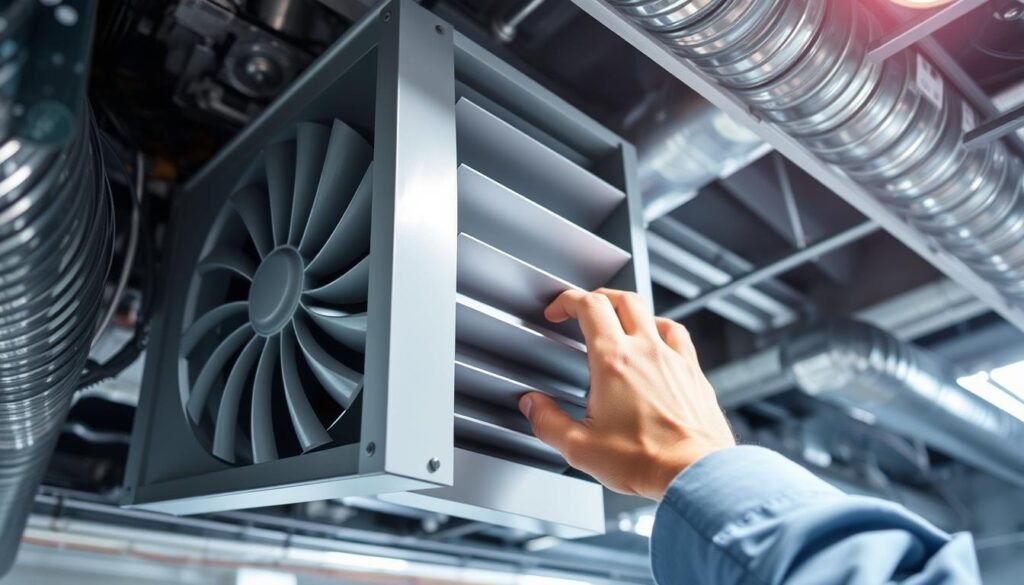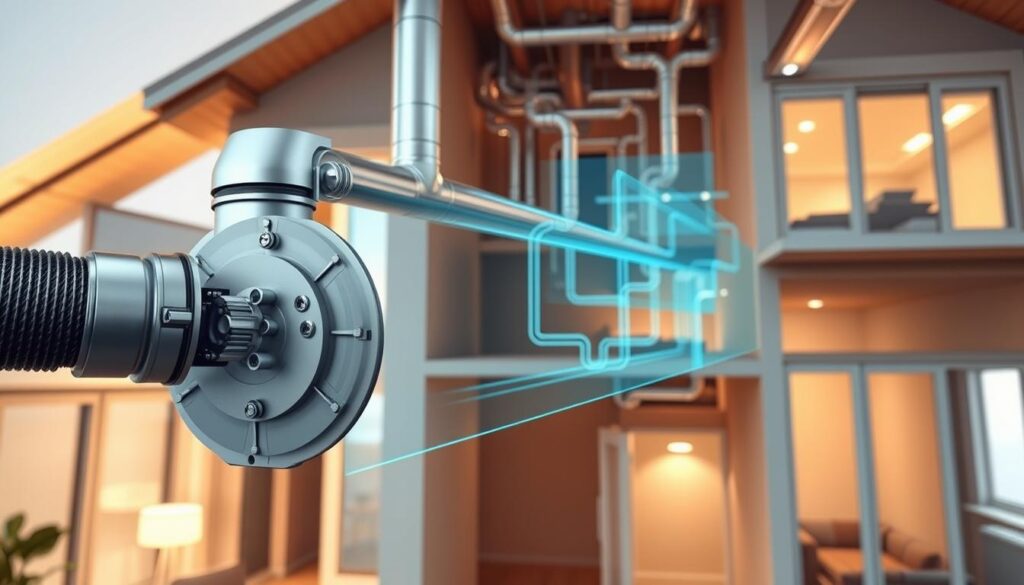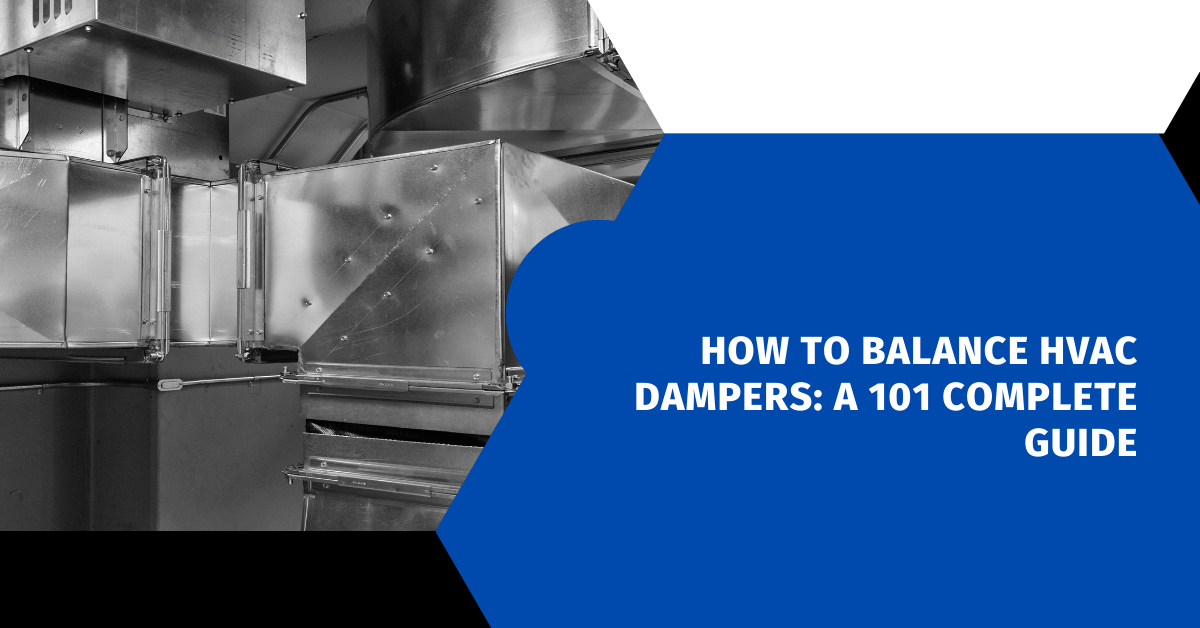Affiliate Disclosure
HVAC Guide Guys is a participant in the Amazon Services LLC Associates Program, an affiliate advertising program designed to provide a means for sites to earn advertising fees by advertising and linking to Amazon.
How to Balance HVAC Dampers? Are you tired of rooms that feel like a freezer while others resemble a sauna? What if you could master residential duct balancing and create the perfect temperature throughout your home?

HVAC dampers are the unsung heroes of home climate control. These strategic valves in your ductwork determine which areas receive heated or cooled air. This ensures your entire living space remains comfortable.
Understanding how to balance HVAC dampers can transform your home’s comfort level. This guide will walk you through the essential techniques. You’ll learn how to optimize your heating and cooling system. This will help you achieve consistent temperatures and potentially reduce energy costs.
Key Takeaways
- Learn the fundamental role of HVAC dampers in home temperature regulation
- Discover step-by-step methods for residential duct balancing
- Understand how proper damper adjustment improves overall system efficiency
- Recognize the impact of balanced airflow on home comfort
- Gain insights into DIY damper balancing techniques
Explore Our HVAC Shop
Looking for top-rated HVAC tools, parts, and accessories? Visit our shop and find the perfect solution for your needs.
Visit the ShopUnderstanding HVAC Dampers and Their Purpose
HVAC dampers are key parts of your home’s heating and cooling system. They help control airflow and temperature. This makes your home more comfortable by adjusting air flow to different areas.
Dampers work like valves, controlling air flow through ducts. They are placed carefully to manage air movement. This makes your HVAC system more efficient.
Types of HVAC Dampers
There are various damper types for different needs in your HVAC system:
- Butterfly Dampers: Circular plates that rotate to control airflow
- Blade Dampers: Rectangular plates that slide to manage air passage
- Inlet Vane Dampers: Located near fan inlets to regulate air intake
- Louver Dampers: Adjustable slats that provide flexible air direction
Key Functions of Dampers in HVAC Systems
Dampers have important roles in your home’s comfort and energy use:
- They control air volume to different rooms
- Balance temperature across multiple zones
- Reduce energy consumption by limiting unnecessary airflow
- Allow targeted heating and cooling
Benefits of Proper Damper Operation
Properly maintained and adjusted dampers offer many benefits. They make your home more comfortable. They also reduce strain on your HVAC equipment and may lower energy bills.
Explore Our HVAC Shop
Looking for top-rated HVAC tools, parts, and accessories? Visit our shop and find the perfect solution for your needs.
Visit the ShopEssential Tools and Equipment for Damper Balancing
To adjust dampers manually, you need specific tools. These tools help you measure and calibrate your HVAC system’s airflow. The right tools ensure your damper is set correctly for the best system performance.
Here are the essential tools you’ll need for effective HVAC damper balancing:
- Measuring Instruments
- Vane anemometer for measuring air velocity
- Digital thermometer for temperature readings
- Thermal imaging camera for detecting temperature variations
- Basic Hand Tools
- Adjustable screwdrivers
- Needle-nose pliers
- Tape measure
- Sealing and Repair Materials
- Duct tape
- Mastic sealant
- Weatherstripping
Choose tools that are accurate and versatile for manual damper adjustment. A good vane anemometer gives you precise airflow measurements. A thermal imaging camera helps spot issues that might affect your damper’s position.
Pro Tip: Invest in digital tools that offer precise measurements and can help you diagnose HVAC system performance more effectively.
Having the right tools is just the start for balanced airflow in your home. You also need the right technique and careful measurement for successful HVAC damper balancing.
Locating HVAC Dampers in Your System
It’s important to know your HVAC system’s layout for better performance. Dampers help control airflow and keep temperatures even in your home.
Your HVAC system has key spots for dampers. Knowing these areas helps you manage airflow better and boost system efficiency.
Common Damper Placement Areas
- Main trunk lines before and after major junctions
- Branch ducts connecting to primary ductwork
- Near supply vents in different rooms
- Intersection points of multiple duct paths
Identifying Different Damper Designs
HVAC dampers vary in design, each with its own purpose. You’ll mainly find:
- Manual dampers: Need to be adjusted by hand
- Automatic dampers: Controlled by your HVAC system
Reading Damper Position Indicators
Modern dampers have indicators to show their position. These indicators tell you if the damper is:
- Fully open
- Partially open
- Completely closed
To get the best out of your system, watch these indicators closely. Understanding them helps you keep temperatures even in your home.
Explore Our HVAC Shop
Looking for top-rated HVAC tools, parts, and accessories? Visit our shop and find the perfect solution for your needs.
Visit the ShopPreparing Your HVAC System for Balancing
Getting your HVAC system ready for airflow optimization is a detailed process. Before starting air balancing methods, you must complete several important steps. These steps help ensure accurate measurements and effective damper adjustments.
First, gather all the necessary system documents. This is key for optimizing hvac airflow. Your checklist should include:
- Duct design calculations
- Detailed duct layout diagrams
- Complete equipment specifications
- Control system documentation
Then, do a thorough system check. This step involves examining key components to prepare for balancing:
- Inspect and clean or replace air filters
- Check for potential duct leaks
- Verify all vents and registers are completely unobstructed
- Ensure proper fan and blower functionality
Setting your thermostat correctly is critical for successful air balancing. Make sure your system keeps a consistent temperature during balancing. Set the fan to “auto” mode and choose a moderate temperature setting that matches typical use.
By carefully preparing your HVAC system, you’ll set up the best conditions for precise airflow measurements and effective damper adjustments. This groundwork is crucial for achieving balanced, efficient heating and cooling in your space.
How to Balance HVAC Dampers Step by Step
Balancing your HVAC dampers is key for even comfort in your home. It needs precision and attention to detail. This guide will show you how to get the best airflow and temperature control.
Adjusting dampers right involves a step-by-step method. It helps distribute heat and cool air better. First, get these tools ready:
- Measuring tape
- Airflow measuring device
- Screwdriver
- Notebook for recording measurements
Initial System Assessment
First, check how your HVAC system is doing. Look at each room’s temperature and find any uneven spots. This helps you know which dampers to adjust.
Measuring Airflow at Registers
Measuring airflow accurately is key for balancing. Use a device to find the cubic feet per minute (CFM) at each register. Write down these readings carefully.
| Room | Initial CFM | Desired CFM | Damper Adjustment |
|---|---|---|---|
| Living Room | 210 | 250 | Partially Open |
| Bedroom | 180 | 200 | Slightly Open |
| Kitchen | 190 | 220 | Moderate Adjustment |
Making Damper Adjustments
Start adjusting dampers slowly and carefully. Turn the handles a little at a time. Then, check the airflow again. Being patient is important for balanced airflow.
- Open or close dampers in small steps
- Check airflow again
- Write down any changes
- Keep adjusting until it’s right
Remember, balancing HVAC dampers takes time and patience. Make small, careful changes. This will help you get the best comfort in your home.
Explore Our HVAC Shop
Looking for top-rated HVAC tools, parts, and accessories? Visit our shop and find the perfect solution for your needs.
Visit the ShopSeasonal Damper Adjustment Guidelines
Managing your HVAC system’s performance through different seasons needs smart damper adjustments. Knowing about hvac zoning techniques helps keep your home’s temperature even all year.

In summer, focus on cooling efficiency with your damper strategy. You’ll want to adjust dampers so cool air gets to all parts of your home well.
- Open upper-level dampers to distribute cool air evenly
- Close dampers in less-used spaces to optimize cooling
- Consider sun exposure when adjusting damper positions
Winter calls for a different damper management approach. Warm air naturally rises. So, you’ll need to change your damper settings to keep heating consistent across your home’s levels.
| Season | Damper Strategy | Temperature Goal |
|---|---|---|
| Summer | Open upper-level dampers | Cool and consistent |
| Winter | Close upper-level dampers | Warm and balanced |
Creating a seasonal adjustment schedule helps track and improve your HVAC system’s performance. By using these hvac zoning techniques, you’ll keep your home comfortable all year, no matter the weather outside.
Troubleshooting Common Balancing Issues
Residential duct balancing can sometimes present unexpected challenges, even for homeowners who carefully manage their HVAC airflow optimization. Understanding how to identify and resolve common issues will help you maintain a comfortable and efficient home environment.
Dealing with Uneven Airflow
Uneven airflow can create uncomfortable temperature zones in your home. To address this problem, consider these strategies:
- Check for blocked or partially closed dampers
- Inspect ductwork for potential leaks or obstructions
- Verify that register openings are fully operational
- Use a digital airflow meter to measure precise air distribution
Addressing Temperature Inconsistencies
Temperature variations between rooms can signal underlying HVAC airflow optimization challenges. Potential solutions include:
- Recalibrating damper settings
- Cleaning or replacing air filters
- Examining insulation quality in different zones
- Considering supplemental zoning systems
Resolving Noise Problems
Unusual sounds during residential duct balancing might indicate mechanical issues. Investigate potential noise sources such as:
- Loose damper connections
- Worn bearings in HVAC components
- Misaligned ductwork sections
- Excessive air pressure in specific zones
When DIY troubleshooting fails to resolve persistent HVAC performance issues, consulting a professional technician can provide advanced diagnostic and repair solutions.
Explore Our HVAC Shop
Looking for top-rated HVAC tools, parts, and accessories? Visit our shop and find the perfect solution for your needs.
Visit the ShopAdvanced Balancing Techniques for Multi-Story Homes
Managing HVAC zoning in multi-story homes is a special task. It’s because heat naturally rises, making it hard to keep temperatures even. This creates challenges for keeping your home comfortable.

Getting the damper position right is key in multi-level homes. You need a detailed plan that covers a few important points:
- Understanding the stack effect and its impact on air distribution
- Creating independent temperature zones for each floor
- Utilizing advanced bypass damper strategies
- Integrating smart thermostat technologies
Here are some advanced HVAC zoning techniques to try:
| Technique | Key Benefits |
|---|---|
| Stairwell Air Management | Reduces temperature stratification |
| Multi-Zone Damper Systems | Provides precise temperature control |
| Smart Thermostat Integration | Enables dynamic airflow adjustment |
If you’re still having trouble, getting help from an HVAC design engineer is a good idea. They can create a plan that fits your home’s specific needs.
Professional tip: Regularly calibrate your dampers and reassess your zoning strategy to maintain optimal home comfort.
Maintaining Balanced Airflow Throughout the Year
Keeping your HVAC system in top shape needs ongoing effort and smart maintenance. HVAC airflow optimization is not a one-time job. It’s a continuous process that changes with the seasons and your home’s needs.
Your home’s comfort depends on even temperature all year. To get this, follow these important maintenance tips:
- Check damper settings every three months
- Watch how temperatures change with the seasons
- Adjust damper settings for how you use each room
- Keep an eye on how well your system moves air
Using smart technology can really boost your HVAC’s performance. Digital thermostats and automated damper systems give you live updates on your home’s temperature and air flow. This makes it easier to keep things balanced.
Changes in your lifestyle, like moving furniture or changing room uses, can affect your HVAC. Stay ahead by:
- Setting up a seasonal maintenance schedule
- Ensuring register positions are right
- Cleaning air vents and filters
- Testing air flow in different areas
By using these methods, you’ll keep your home comfortable, save on energy, and make your HVAC last longer.
Explore Our HVAC Shop
Looking for top-rated HVAC tools, parts, and accessories? Visit our shop and find the perfect solution for your needs.
Visit the ShopWhen to Call a Professional HVAC Technician
Residential duct balancing can be tough, and some problems need a pro. While many homeowners handle basic HVAC tasks, some complex issues require a professional’s touch.
Signs of Complex Balancing Problems
Knowing when to call a pro is key for your HVAC system’s health. Look out for these signs that mean you need expert help:
- Persistent temperature variations between rooms
- Unusually high energy bills
- Strange noises from the HVAC system
- Uneven airflow across different zones
- Reduced system performance despite regular maintenance
Professional Balancing Services
Professional HVAC technicians have the skills for residential duct balancing. They use advanced tools and methods to tackle tough system problems:
- Comprehensive system assessment
- Precision airflow measurements
- Advanced diagnostic equipment
- Detailed ductwork analysis
- Customized system optimization
Getting professional balancing services can boost your HVAC system’s efficiency. It can also extend your equipment’s life and make your home more comfortable. Certified technicians offer solutions that go beyond simple adjustments.
Expert HVAC technicians can diagnose and resolve complex system imbalances that DIY methods cannot address.
Conclusion
Balancing HVAC dampers is key to better indoor comfort and energy use. It turns your home’s climate control into something top-notch. You need patience, precision, and a step-by-step plan for the best airflow.
Improving your HVAC system doesn’t stop after the first tweaks. Regular upkeep and seasonal checks are vital. Remember, air balancing is a cycle. You’ll need to check and adjust outlets many times to get it right.
Some folks can handle damper adjustments on their own. But, complex systems might need a pro. If you’re stuck or unsure, call a certified HVAC tech. They can avoid damage and keep your home comfy.
Learning to balance HVAC dampers is about making your home cozy and efficient. With the tips from this guide, you can improve your home’s climate control. This effort will save you money and keep your system running smoothly.

